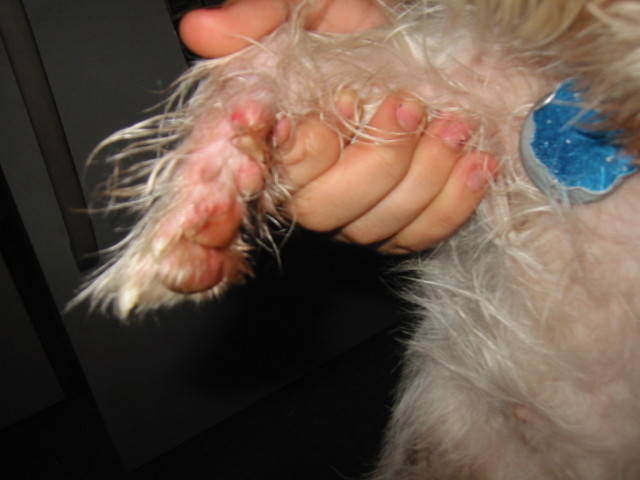QuestionMy goldendoodle started having irritated eyes and face which
included some scabbing about a year ago, after being
groomed. My vet said he seems to have allergies and treated
with a corticosteroid injection and antibiotic eye ointment.
His eyes improved for a brief time but never got totally
better. He now has dark areas on his front elbows and the
area around his anus which make him look dirty. I
personally have been itchy for a long time and have been
treated symptomatically with Atarax, Benadryl, etc. About
two months ago I started to get "bites" and lesions on my
body which have spread all over. My doctor says it is
consistant with scabies but a couple common characteristics
are not present. In the last two days I discovered scabbing
on my older dogs front elbows. Upon my vets advice I
started treating my dogs with Revolution, and upon my
doctors advice am treating myself with Kwellada.
My home environment is very clean. Upon learning about
mites I bleached, steamed and used uvb light on everything
possible in my home. I should add that a chihuahua puppy
was added to our household 2 months ago and as of yet seems
mainly unaffected aside from some mild scratching now and
then.
Many say the same species of mite cannot live off both
humans and dogs. Is this one huge coincidence? I feel
certain there is a connection but am told repeatedly there
is not.
Answer
Hi Karen,
There are three forms of mites (also called Mange) which dogs can get. They are; Demodectic, Cheyletiella, and Sarcoptic. To know if your dog has any of these mites, your vet needs to do a skin scraping test (an easy and painless test done at the vet's office). It's important to identify to type of mite, so the dog can get the correct treatment.
Sarcoptic mange (also known as Scabies) is contagious to humans. It is microscopic, so you won't see these mites. If the dog shares sleeping places with you, or if the infected dog sleeps on beds or furniture, everyone will begin scratching. Telltale signs of Sarcoptic mange are crusty ear tips, fierce itching, and hair loss, particularly on the ears, elbows, legs, and face in the early stages. Later on, the hair loss spreads throughout the body.
Demodectic mange is also a microscopic mite. You didn't say how old your dog is, This mange strikes puppies from three to 12 months old. demodectic mange symptoms include thinning of the hair around the eyes and mouth and on the front legs that evolves into patches of hair loss approximately one inch in diameter. This mange may correct itself within three months or may require treatment. Humans can catch this form of mange mites from their dogs.
Cheyletiella mange is not microscopic. It is caused by a reddish mite that can be seen under a magnifying glass. This mange is identified by the dandruff dusting that occurs over the dog's head, neck, and back. This form of mange is highly contagious but short-lived. It causes mild itching. The mite that causes the mange dies a short time after leaving the dog. Still, if this variety of mange mite bites a human, it can cause a itchy red welt like a mosquito bite. Several of these bites can be rather troublesome. Since these varieties are not well adapted to humans, they do not produce the extensive tunnels and cause the advanced lesions and scabs over the skin surface. The mite just burrows in a short distance and dies. This causes inflammation and the resulting welt.
The symptoms of Mange can mimic other skin conditions, including autoimmune diseases, bacterial infections secondary to flea allergies, and contact dermatitis, which is why it's important to do the proper diagnostic testing. Medications such as corticosteroids may temporarily control the itching, but does nothing to control or cure the underlying cause of the itch.
Since negative test results do not rule out mite infection, a "Maybe Mange" test is frequently performed. This consists simply of treating for Sarcoptic mange and observing for resolution of the signs within 2-4 weeks. Treatment is very simple and highly successful in most cases so it is fairly easy to rule out Sarcoptic mange with a trial course of medication. If you aren't seeing results from using Revolution, you should try an Ivermectin based medication, such as Frontline.
I hope that helps,
Patti

 puppy behavior
Question
Cooper and Guy
Hi, thanks so much for reading
puppy behavior
Question
Cooper and Guy
Hi, thanks so much for reading
 Dog Breed.
Question
Recent photo this week
Hello,
I saw that you
Dog Breed.
Question
Recent photo this week
Hello,
I saw that you
 dew claw bleeding
Question
tashas paw
Hi I have a 2yr old female shutzu/M
dew claw bleeding
Question
tashas paw
Hi I have a 2yr old female shutzu/M
 what is my dog????
Question
Connie
Patti, i got my dog Connie a few months
what is my dog????
Question
Connie
Patti, i got my dog Connie a few months
 2nd Dog
Question
Winston
Hi, I have a beagle/bassest hou
2nd Dog
Question
Winston
Hi, I have a beagle/bassest hou